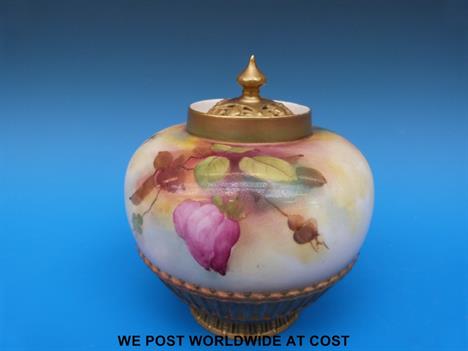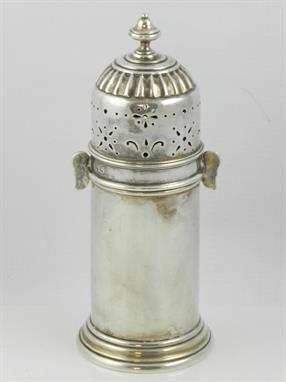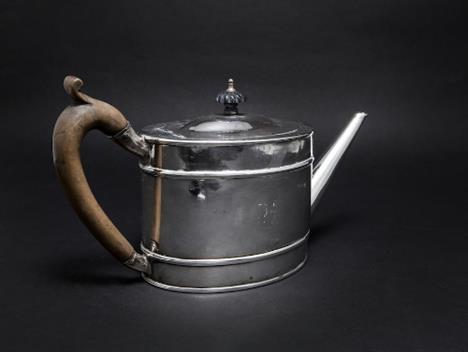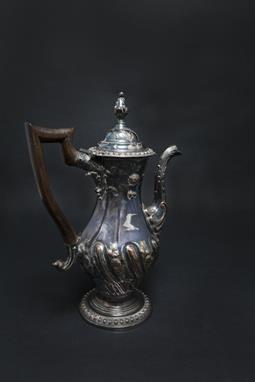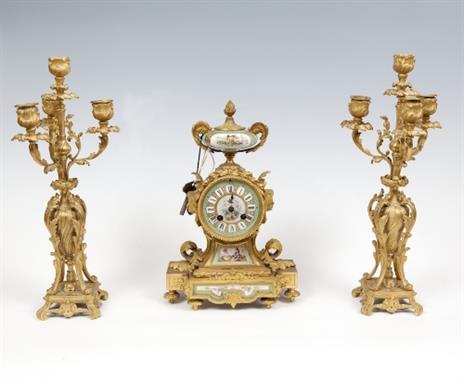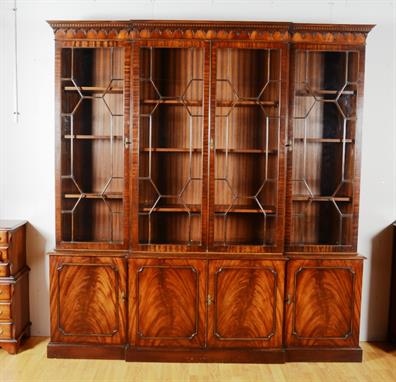We found 116003 price guide item(s) matching your search
There are 116003 lots that match your search criteria. Subscribe now to get instant access to the full price guide service.
Click here to subscribe- List
- Grid
-
116003 item(s)/page
AN IRISH VICTORIAN SILVER PEAR SHAPED COFFEE POT, Dublin 1885, mark probably that of John Smith, retailed by E.M. & Co., handle and lid marked, the foliate finial (apparently un-marked), applied to a domed circular lid with continuous foliate decoration, applied 'c' scroll handle chased with acanthus leaf texture, the body with slender neck decorated with stylised panels with hanging bellflowers and foliage, the body embossed and chased with roses and flowering poppies, amongst scrolls enclosing opposing cartouches, crested to one side with rearing lion, and engraved with initials to the other, raised on a circular spreading foot (c. 31ozs). 27cm high, 23cm wide over handle and spout
AN OVAL SILVER TEAPOT, London 1904, mark of West & Son, with applied ebonised finial and 'c' scroll handle, domed hinged cover, with shaped out-turned rim, inverted slender neck, the downswept body decorated with embossed stylised flutes in low relief, crested with perched bird of prey, raised on an oval foot (c.18ozs all in). 12cm high, 27cm wide over handle and spout
A George III silver Adam style butter dish and cover, London 1772, mark of Aldridge Green, of oval tub form, with couchant cow finial, decorated overall with pierced lattice-work interposed with medallions and draped swags, two medallions crested and having blue glass liner (c.9.5ozs incl. finial which is apparently unmarked). 16.5cm wide, 11cm deep, 12cm high Provenance: Deepwell, Blackrock, Co. Dublin
A FRENCH ORMOLU AND PORCELAIN MOUNTED THREE PIECE CLOCK GARNITURE, 19th century - composed, the clock surmounted with classical urn and acorn finial over a drum cased movement with floral painted ceramic dial flanked by ormolu masks and acanthus leaves, supported on a breakfront plinth base, 33cm high. The associated cassolettes formed with three naturalistic branches and raised central socket, foliate cast body and platform base 41cm high
A Victorian electrotype lidded urn of gilt and silvered metal, the handles festooned with grapes, the sides decorated with cherubs bearing baskets of fruit and flowers, with crane finial, stamped to side with initials V P with crown, possibly for William Vaughan Palmer (active 1841-52), mounted on white marble base, approx. 29cm high.
A George III silver nutmeg grater of plain vase form with hinged lid having ball finial, the lid opens to show a hinged body with internal grater, the front of the body having a single engraved letter to the centre, hallmarked with George III and lion assay marks with makers initials `ML`, height 7cm, total weight 36.9g.
A George III silver teapot and stand, initialled, and with seaweed style engraved decoration, London 1804, approx. 17.125 ozt (all in) (2) See illustration Condition report Report by NG Teapot - approx. measurements 16 cm high, 24.5 cm handle to spout, body approx. 13 cm wide, and 10 cm deep. Marks to teapot base clear. Maker's mark slightly rubbed. Maker's mark reads A.B G.B. Marks to stand in similar condition. Handle probable replacement, silver band unmarked. The lid slightly bent and does not close flush. Surface scratching and some shallow dents. Cartouche engraved with R to each side. End of spout split and bent. Finial loose. Interior shows signs of use. Stand - measurements approx. 13.5 x 11.5 x 2 cm. Surface -scratches and dented. Legs slightly bent. Both pieces scratched as though been tested.
A William IV silver teapot, with a flowerhead finial, Edward, Edward Jr, John and William Barnard, London 1836, approx. 25.170 ozt, 17 cm high See illustration Condition report Report by NG Surface tarnished and with scratches. Hinge of cover is firm but there is a small gap between cover and teapot nearest spout (approximate fingernails width). Handle wobbly. Several dents in the body around the widest circumference, some more pronounced than others. Also dent in base. Hallmarks to base clear, another stamp of a cross and three dots to base and 828 (?) stamped to base. Partial set of hallmarks to base of handle, this also stamped 828 (this number is double stamped and messy) these marks slightly rubbed. Partial set of hallmarks to finial, grubby but legible. Hallmarks to inside of lid, makers mark rubbed. From inside of lid small dent visible under finial. Wing nut securing finial also stamped with lion passant no monograms or crest.
**AN EAST AFRICAN SHIELD, SOMALIA, 19TH CENTURY of strongly convex circular form, the outer surface tooled and rising to a low domed finial, the interior fitted with a robust enarme 50.5 cm; 19 ¾ in diameter Provenance Albert R. Louis, sold Walpole Galleries, New York, 22 February 1927, lot 149 JWHA Inv. No. 119
**AN INDIAN SWORD (PATISSA), 17TH CENTURY with broad flat blade etched in imitation of watered steel swelling towards a sharp `swallow`s tail` point, iron hilt comprising figure-of-eight shaped guard (cracked on one side) drawn-down in the centre to form a very long pair of moulded langets enclosing the lower portion of the blade, shallow cup-shaped pommel (perhaps associated) with tapering moulded attenuated finial 76.5 cm; 30 1/8 in blade Provenance The Museum archives record this as an anonymous gift 1 February 1934 JWHA Inv. No. 2056
**AN INDIAN EXECUTIONER`S SWORD (TEGHA), LATE 18TH/19TH CENTURY with characteristic very broad blade double-edged for its upper third, chiselled with four long panels, an architectural framework filled with exotic beasts and encrusted with brass deities in low relief on each side, iron hilt of talwar form, including recurved knuckle-guard with serpent head finial, and decorated over its surface with silver flowers 74.5 cm; 29 3/8 in blade Provenance The Museum archives record this as an anonymous gift 1 February 1934 JWHA Inv. No. 2072
**AN OTTOMAN HELMET, 19TH CENTURY, PROBABLY SUDAN with domed skull, fitted at the top with a rudimentary finial on a large engraved brass washer, long fixed nasal bar, and retaining its mail neck-defence (losses, some replacements) the first: 31.5 cm; 12 ½ in high Provenance Sotheby & Co. ,7 July 1924 Fenton & Sons, London, 10 March 1928, no. 941 JWHA Inv. No. 517
**A VENETIAN SCHIAVONA, SECOND HALF OF THE 18TH CENTURY with broad blade double-edged towards the point, cut with a long shallow fuller and etched with an elaborate design of scrolling foliage and flowers on each face, struck with a bladesmith`s mark, a bull in a rondel, on the reverse, characteristic iron hilt, comprising straight quillon with moulded finial, basket-guard, thumb-loop, brass shield-shaped pommel chiselled with a flower on each side, and original wooden grip with `Turk`s heads`, the lower portion retaining an early leather tasselled washer (binding missing) 90 cm; 35 1/2 in blade Provenance Giulia P. Morosini, sold American Art Association, Anderson Galleries Inc., New York, 10-15 October 1932 JWHA Inv. No. 1773 Exhibited Schnectady Museum, New York, 5 June - 13 September 1979 Lowe Museum, Miami, Florida, 1 December 1979 - 13 January 1980
**A COMPOSITE GERMAN CUIRASSIER`S ARMOUR, IN PART PROBABLY BY MARTIN SCHNEIDER THE YOUNGER, NUREMBERG, CIRCA 1620 comprising Zischägge with a two-piece hemispherical skull joined along the crest of a low file-roped medial comb fitted at its rear with a modern plume-tube of brass, the skull projecting forward to a short, obtusely-pointed integral peak pierced at its centre with a rectangular slot to receive a sliding nasal-bar (restored) expanding at its lower end to a large rounded triangular finial and secured at the brow by a modern staple and screw, fitted at the nape with an associated neck-guard of three lames, the last of which is formed at its lower edge with a prominent central cusp, and at each side with a modern forward-sloping hinged cheek-piece of two lames, the upper one embossed with a flower-head, collar of two lames front and rear (the lower rear one restored), one-piece backplate of late `peascod` fashion, struck internally, just below the neck, with the large letter `T`, and formed at it lower edge with a flange later fitted at each side with a projecting screw and wing-nut to attach a pair of composite cuisses each formed of a single boxed upper lame from which are suspended, by means of a pair of modern straps and buckles, a further eleven lames of which the last is fitted at its lower edge with a poleyn of four lames, one-piece breastplate struck at the neck with the quality-control mark of the city of Nuremberg and a maker`s mark consisting of a pair of scissors within a shield, and formed at it lower edge with a short flange, large asymmetrical pauldrons (not a pair), the left of seven lames and the right of six, two vambraces (not a pair) of fully articulated tubular form, each of late 16th century Italian make and fitted at its upper edge with a turner of one lame and at its elbow with a bracelet couter of three lames, and two gauntlets (not a pair) each formed of a flared and pointed cuff with a separate inner plate, several metacarpal-plates (four in the case of the left and five in the case of the right), a knuckle-plate decorated with a file-roped transverse rib, and a shaped finger-plate (composed and in part reworked from old plates), the main edges of the armour formed with inward turns, mostly roped and in many cases accompanied by lining-rivets retaining the remains of crimson velvet piccadils edged with gold bullion, and a few of the main edge, along with most of the subsidiary ones and three divergent bands of the breastplate and backplate respectively decorated with double or treble incised lines (in part later additions) gilt against a blued ground (some minor damage and patching throughout) Provenance Sumner Healey, New York, 6 June 1932 Exhibited `The Art of Collecting, J. W. Higgins Museum, Worcester, Massachusetts, October, 1984 Travelling exhibition visiting several locations in the south of the U.S.A. February 2004- September 2008 JWHA Inv. No. 1737 The mark of the scissors struck on the backplate is probably identifiable as that of the Nuremberg armourer Martin Schneider the Younger (his surname translates into English as `Tailor` ). The same or similar mark can be found on other Nuremberg pieces such as a steel target in the Historisches Museum, Dresden (Ehrenthal 1898, p. 34), as well as another in the J. W. Higgins Armory Museum, Worcester, Massachusetts, JWHA Inv. No. 2647 (`The Age of Armor`, 13 February 2003 - 31 August 2003). It is also to be found on an armour in the Musée d`Art et d`Histoire, Geneva, and a breastplate in the Hallwyll House Museum, Stockholm, Cat. No. E.2.
**A POLISH HUSSAR`S ARMOUR WITH APPLIED BRASS ORNAMENT, SECOND HALF OF THE 17TH CENTURY WITH ADDITIONS AND EMBELLISHMENT OF THE 18TH OR 19TH CENTURIES comprising two-piece hemispherical skull joined medially by rivets and decorated with four trios of incised lines radiating from a central finial with washer of iron and brass, fitted at its rear with a later neck-guard of four lames, at each side with a later pendent scutiform cheek-piece pierced at its centre with a heart, and at its front with a flat obtusely-pointed peak flanged downwards at its front edge and pierced at its centre rear with a rectangular slot to receive a broad sliding nasal-bar (restored) expanding at its lower end to a foliate finial and secured at the brow by a modern staple and screw, pair of later pauldrons each formed of seven lames of which the lowest five protect only the outside of the arm and extend downwards to just above the elbow, and breastplate and backplate of great weight with outward-flanged neck and arm-openings, each formed of a main plate covering the thorax and three upward-overlapping waist-lames covering the abdomen, the breastplate medially-ridged, the backplate slightly hollowed between the shoulder-blades and the two elements merely butting against one another at the sides, the armour decorated throughout with scalloped brass borders ornamented with punched circles and involving at the right and left of the chest respectively an applied cross paté and a circular medallion cast and chased in low relief with a figure of the Virgin, and elsewhere with bosses and rosettes of the same material, the subsidiary edges of the pauldrons decorated with scalloping, and those of the cuirass with two rows of punched circles separated by punched diagonal lines Provenance William Ockelford Oldman, London, 4 January 1929, his no. 19, £25 JWHA Inv. No. 568 For discussions of this type of armour see A. Nadolski, `Ancient Polish Arms and Armour, Part II`, Journal of the Arms and Armour Society, Vol. IV, no. 9, March 1964, pp. 170-86; and Zdzislaw Zygulski Jr, `The Winged Hussars of Poland`, Arms and Armor Annual, Vol. I, Chicago, 1973, pp. 90-103. While incorporating original elements of the 17th century, all appear subsequently to have been added to and decorated, probably for ceremonial use in the 18th or 19th centuries. In the case of the present armour its helmet and cuirass are of the 17th century but its pauldrons, neck-guard, cheek-pieces and decoration are later.
**A GERMAN CLOSE HELMET WITH PEAK AND FALLING BUFFE, MID-16TH CENTURY AND 19TH CENTURY with skull (originally forming part of a burgonet and patched at its right side), boxed in four panels and rising to a point surmounted by a small acorn finial, its right side struck with the spurious quality-control-mark of the city of Nuremberg, peak and buffe attached to the skull by common pivots, the buffe formed of a main plate shaped to the chin and fitted at its upper edge with two falling plates each supported at the right side by a sprung stud, the upper one pierced with a pair of horizontal ventilation-slots and the lower with eight crescentic ventilation-holes above four of a star-shaped form, and two gorget-plates front and rear, the main edges of the helmet formed with roped turns (all parts except the skull restored) 35 cm; 13 3/4 in high Provenance Henry Furmage, London, 21 April 1931 £80 JWHA Inv. No. 1460 Exhibited `Renaissance Hardwear: The Art and Technology of Armor`, National Ornamental Metal Museum, Memphis, Tennessee, 4 September 1987 - 3 January 1988 `Road Warriors: Knight Riders`, Norton Museum of Art, West Palm Beach, Florida, 24 June - 4 September 2000
**A RARE SOUTH GERMAN SKULL OF A ZISCHÄGGE, SECOND HALF OF THE 16TH CENTURY of ogival form terminating at its apex in an acorn finial and fitted just beneath it with a later conical brass cap, decorated between the lower edge of the cap and a narrow recessed border at the lower edge of the skull with close-set vertical flutes, pierced at its lower edge with various holes for the attachment of a peak, neck-guard and cheek-pieces, and later fitted over the brow with two conical bosses and rosette-washers of brass, and, to the right of them, with a bell-shaped plaque also of brass (the whole heavily patinated and showing a few rust perforations) 23 cm; 9 in high Provenance Henry Furmage, London, 15 April 1931 Helmets such as this were made in imitation of the Turkish shishak. Other examples of the type are discussed by Mann 1962, Vol. I, pp. 109-10, pl. 59; Norman 1986, p.48; and Gamber and Beaufort 1990, pp. 165-4, pl. 77. Five examples, dating from about 1563, are illustrated in the pattern-book of the Augsburg etcher Jörg Sorg the Younger (Becher et. al., 1980, p. 91) JWHA Inv. No. 1470
**A GERMAN ZISCHÄGGE, CIRCA 1620-30 with hemispherical skull fitted at its apex with a transversely-pieced finial retaining a large circular washer, decorated between the washer and a broad recessed border at the lower edge of the skull with twenty-four flutes, fitted at the brow with a narrow medially-grooved peak projecting forward to an ogival front edge and pierced at its centre-rear with a rectangular hole to accommodate a sliding nasal-bar retained by a staple and wing-headed screw (restored), the spatulate lower end of the nasal-bar decorated with rivets, the skull fitted at the nape with a slender tubular plume-holder and beneath it with a slightly flaring neck-guard of five lames the lowest of which has an ogival free edge, and fitted at each side with a large pendent scutiform cheek-piece of three lames embossed in relief at the centre of the uppermost one with a heart pierced with seven small auditory holes, the main edges of the helmet formed with plain inward turns accompanied for the most part by later small paired stitch-holes for attaching a lining and its subsidiary edges bevelled, the helmet painted black except on the fluted portion of the skull, the embossed hearts of its cheek-pieces, all the edges of its plates, and the domed heads of its rivets (the fluted portion of the skull extensively patinated and showing some delamination and perforation of its metal) 34.5 cm; 13 1/2 in high Provenance JWHA Inv. No. 937
**A GERMAN ZISCHÄGGE, MID-17TH CENTURY with one-piece hemispherical skull embossed with six radiating ribs and fitted at its apex with a transversely-pierced finial and circular washer, at its brow with a flat obtusely-pointed peak, at its nape with a flaring neck-guard of four lames, and at each side with a pair of pendent scutiform cheek-pieces in each case detached and pierced with seven auditory holes in rosette-formation, the peak struck on its underside with the characters ++VIII and pierced at its rear with a rectangular hole to accommodate a sliding nasal-bar with a leaf-shaped upper end, retained by a staple and locking-screw at the brow, the main edges of the helmet formed with plain inward turns and its surfaces coloured black overall 27 cm; 10.5 in high Provenance His Imperial Highness, Archduke Eugen, Veste Hohenwerfen, Austria, sold, Anderson Galleries, New York, 2 March 1927, lot 401, $12.50 JWHA Inv. No. 152
**A GERMAN ZISCHÄGGE, MID-17TH CENTURY with one-piece hemispherical skull embossed with six radiating ribs and fitted at its apex with a transversely-pierced finial and circular washer, at its brow with a flat obtusely-pointed peak, at its nape with a flaring neck-guard of four lames (the rear edge exhibiting a few small cracks), and at each side with a pair of pendent scutiform cheek-pieces in each case pierced with seven auditory holes in rosette-formation, the peak pierced at its rear with a rectangular hole to accommodate a sliding nasal-bar with a leaf-shaped upper end, retained by a staple and locking-screw at the brow, the main edges of the helmet formed with plain inward turns and its surfaces coloured black overall 26.5 cm; 10 1/2 in high Provenance His Imperial Highness, Archduke Eugen, Veste Hohenwerfen, Austria, sold, Anderson Galleries, New York, 3 March 1927, lot 534 JWHA Inv. No. 162 Exhibitions `Road Warriors: Knight Riders`, Norton Museum of Art, West Palm Beach, Florida, 24 June - 4 September 2000
**A GERMAN ZISCHÄGGE, MID-17TH CENTURY with one-piece hemispherical skull embossed with six radiating ribs and fitted at its apex with a transversely-pierced finial and circular washer, at its brow with a flat obtusely-pointed peak (pierced to the right of centre with a large suspension-hole) struck on its upper surface with the number 17 and 07 separated by the initials L over B , at its nape with a flaring neck-guard of four lames, and at each side with a pair of pendent scutiform cheek-pieces in each case pierced with seven auditory holes in rosette-formation, the peak pierced at its rear with a rectangular hole to accommodate a sliding nasal-bar with a leaf-shaped upper end struck with the initials LC and retained by a staple and locking-screw at the brow, the main edges of the helmet formed with plain inward turns and its surfaces polished bright (light to moderate pitting and patination overall) 26 cm; 10 1/8 in high Provenance Count Lichtenstein, Schloss Vaduz, Lichtenstein Dr Bashford Dean, Riverdale, New York, purchased from his estate, 15 October 1929 JWHA Inv. No. 784 Exhibited Pennsylvania Museum of Art, Philadelphia, Pennsylvania, 1 December 1931 - 4 January 1932 Berkshire Museum, Pittsfield, Massachusetts, 6 January 1965 - 21 February 1966 Worcester Polytechnic Institute, Worcester, Massachusetts, 12 -15 May 1967
**A ZISCHÄGGE IN THE MID-17TH CENTURY POLISH STYLE, EARLY 20TH CENTURY with one-piece hemispherical skull embossed with six radiating ribs and fitted at its apex with a transversely-pierced finial and large circular washer, at its brow with a flat obtusely-pointed peak struck at the front with the letter `W` and pierced at its rear with a rectangular hole to accommodate a sliding nasal-bar struck on its leaf-shaped upper end with the letter `L`, at its nape with a flaring neck-guard of four lames, at each side with backward-directed fan-shaped `wings` decoratively fretted between radiating ribs, and below them with a pair of pendent scutiform cheek-pieces each pierced with six circular auditory holes in rosette formation, the main edges of the helmet formed with plain inward turns left bright along with the nasal-bar and the ribs of the wings against an otherwise black-painted ground (the latter extensively scuffed) 44.5 cm; 17 1/2 in high Provenance Parke-Bernet Galleries Inc., New York, 25 November 1953 JWHA Inv. No. 3037.2 Similar helmets were sold by Ernst Schmidt of Munich about 1930 (E. A.Mowbray 1966, p. 9, pl. 84, no. 554)
-
116003 item(s)/page


